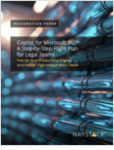While Boeing and transportation-industry officials search for a cause of the battery problems on the 787 Dreamliner plane, the company finds itself in a very familiar position: that of party to an investigation led by the National Transportation Safety Board, a status Boeing has occupied hundreds of times in the last 45 years. And perhaps unlike other types of government investigations, which are conducted once an incident has occurred, this is the kind of investigation in which active involvement by a company can be a welcome opportunity.
In other words: As a party you get to participate in the investigation, says Condon & Forsyth partner David Harrington, who has advised multiple air carriers and aircraft manufacturers during NTSB investigations.
And as Holland & Knight partner Gary Halbert, the former general counsel of the NTSB, puts it: Many times youre working right there beside them.
The NTSB investigates all civil aviation accidents in the U.S., along with significant accidents involving other modes of transport. Yet the relatively small agency (about 400 employees) often cant do it alone. So they seek the expertise from those who have it, such as manufacturers and operators of the vehicles or systems theyre investigating, by offering them party status in the investigation. (The Federal Aviation Administration becomes a party in every aviation investigation the NTSB conducts.)
The primary reason for a company to accept such an invitation from the NTSBwhich has subpoena power, tooaccording to Halbert, is to improve consumer safety. He counsels parties to be responsive, accurate, and helpful in identifying the root cause of an accident. Readily providing assistance also helps a company preserve its reputation as having a focus on safety, he adds.
But party status also comes with access to information about the investigation, along with an opportunity for a company to have input on the investigative process. Its always better to be on the inside of an NTSB inquiry, says Harrington.
During the fact-finding phase, a party can review field notes from the investigation and offer comments if they disagree with the NTSB. Parties can also view information that other companies submit to investigators, just as they can participate in interviews with witnesses. Its not an ironclad rule that you get to see everything, but typically you do, Harrington says.
As an investigation proceeds, Harringtons biggest advice to clients is to maintain an active role. You need to keep a very watchful eye on the NTSB investigation and the direction its taking, he says, adding, If youre going to be a party participant, be a proactive one.
For example, if you think investigators are heading down the wrong path, speak up, says Harrington. And keep a record of points you disagree with. That way, Harrington explains, down the road, a party will be able to say, We suggested that; they didnt do it.
Party representatives to the NTSB generally have technical expertise in areas like safety, quality assurance, or engineering; counsel arent permitted to be the direct link between the agency and the company. What in-house counsel and outside attorneys can do is provide support as the party fields requests for documents and information. For example, a company may need to protect proprietary information from winding up in the public docket that the NTSB produces.
Halbert recommends coming up with a knowledge management system to keep up with requests from the government, which can come fast. That way, a party can ensure its responses are accurateand keep track of the answers it has provided to investigators. Unless you have kept a good record, you cant do that, he says.
Ultimately, its up to the NTSB to determine the probable cause of an event. Parties, however, can provide the agency with whats called a submissiontheir own interpretation on the findingsbefore the final report is released. Its a way of articulating your views of a particular accident to your stakeholders, Halbert says.
While Boeing is the only company thats a party to the NTSBs ongoing 787 investigation, that could change as investigators continue to search for the reason why the planes lithium-ion batteries have caught fire. We may also invite additional parties to the investigation, NTSB Chairman Deborah Hersman said at a press conference on Thursday.
See also: “Regulators Working to Get Boeing Dreamliner Back in the Air,” CorpCounsel, January 2013.





